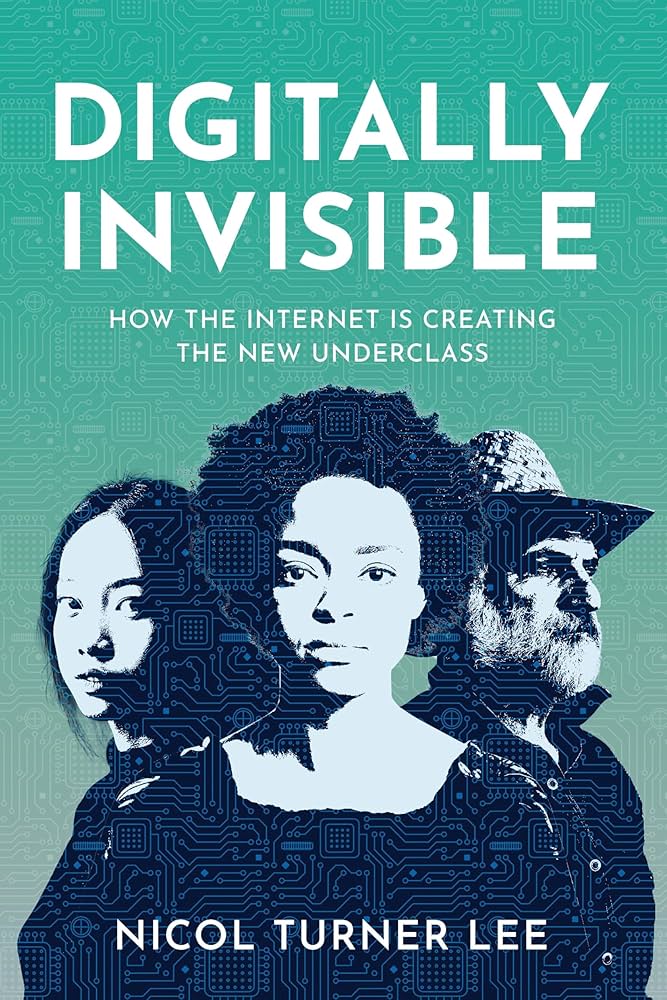A Book Review of 'Digitally Invisible: How The Internet is Creating the New Underclass'
Authored by Dr. Nicol Turner Lee, Digitally Invisible: How the Internet is Creating the New Underclass, tells the stories of many Americans marginalized by race, place, and space. Her definition of the new underclass focuses on those who have been systemically marginalized through the transition into a digital economy and society. This book review positions her work in the 2024 election cycle, and the broader implications for policy and access.
Interested in reading this story on Medium? Check it out here. Interested in saving a PDF? Download it here.
Turner Lee, N. (2024). Digitally invisible: How the Internet is creating the new underclass / Nicol Turner Lee. (1st ed.). Brookings Institution Press. $25.00

Demarcating the Digital Divide
Turner Lee’s role as a computer lab manager at a housing community while in graduate school has inspired her redefinition of the digital divide. She illustrates the many late nights spent with students who needed access to a computer to finish researching and writing their middle school reports. Turner Lee noticed a shift after 9/11. The people she was helping were not doing school reports, they were applying for jobs. Then their digital needs widened further, into commerce, health care, education, and entertainment. Today, without the physical infrastructure to transition and provide equitable digital access in the United States, countless individuals are trapped in a demographic desert, limiting their opportunity to engage with resources hosted only in the cyberspace. The digital divide has “morphed into one of the most significant social divides of our time,” (Rogerson, 2021) and is expected to rapidly grow with the increase in generative AI.
Authored by Dr. Nicol Turner Lee, Digitally Invisible: How the Internet is Creating the New Underclass, tells the stories of many Americans marginalized by race, place, and space. Her definition of the new underclass focuses on those who have been systemically marginalized through the transition into a digital economy and society. Turner Lee uses ethnography to demonstrate that access to digital technology is a social determinant equal to that of education or healthcare.
Turner Lee reframes the digital divide outside of the language of “have’s” and “have not’s” or “information disadvantaged” (Allard, 2001) to a larger issue: systemic marginalization. The money has been allocated to creating these mitigation plans and there is bipartisan support (outlined by Turner Lee’s extensive policy documentation), however, is there actually a drive to fix the digital divide? As other scholars have noted, reframing the language to “digitally invisible” implies the grave consequences for individuals when they do not have access to the technology that enables them to access the Internet (Rogerson, 2021). Using the language “digitally invisible” effectively conveys the compounding axis within the matrix of domination, illustrating the unethical harms to come. (Design Justice, n.d.; D’Ignazio and Klein, n.d.).
Alongside Turner Lee’s ethnography, each chapter is supplemented with the history of government policy recognizing the digital divide up to and including the Biden-Harris administration (Allard, 2001; Mills, 2008; Rogerson, 2021). Calls for research occurred in public policy and technology journals, and since the Clinton administration, funding has begun to trickle in with the intention of mitigating the digital divide. Turner Lee’s book is not just a review of policy or what the tangentially removed should be considering, it is a living document. For the book, Turner Lee was able to facilitate conversations to best support individuals without access. Her work humanizes the digital divide. The book recognizes the need for “hard and truthful conversations on why it has taken so long to make such efforts domestic and international priorities” and starts these conversations not with the experts but with those who must confront and navigate their digital desert daily.
The book is composed of eight distinct locations across the United States, the first being Turner Lee’s computer lab in the late 1990s. Next, she travels to rural counties, urban areas that are low socio-economic status, school districts, and down south to Arizona to learn the stories of the countless individuals excluded from participating in the digital space. Traveling to these ‘digital deserts,’ Turner Lee positions her knowledge within the embodied experiences of those trapped by geography and demography. Found within these demographic deserts, the digital divide leaves communities without proper or reliable digital connection. Most stories like these are epistemically silenced and perpetually subject to “invisibilization” (Bhattacharyya, n.d.; Herzog, 2018).
Recognized as an international human right, access to digital technology serves as a social determinant which exacerbates the current lived conditions (Mills, 2008). The necessity of access to technology is illustrated through the principal Turner Lee met with in New Mexico who had to fight for her children to receive access to tablets after the pandemic. Instead of transitioning everyone into cyberspace (Lessig, 2006) the physical infrastructure (Mills, 2008) we have created has become a new form of infrastructural marginalization that confers limited access to resources based on race, place and space. Turner Lee recognizes the “confluence of various social and geographic contexts, politics, and public policies that are critical to how we understand the role of race, place, and space in determining who has technology access, and at what level of quality” (xii) and guides her analysis with this understanding. The discrimination outlined here is at the core of the conception and persistence of the U.S. digital divide. It is no longer the ‘haves’ and the ‘have nots’ but the will of government and big tech authorities to facilitate connection
Perpetual Limitations of Studying the Digital Divide
The limitations of Digitally Invisible are neither unique nor any fault of Turner Lee’s. The primary research conducted for this book occurred before the COVID-19 pandemic. In writing, she was able to bring in and provide follow ups about how communities and the government responded to a now immediate and much larger population of students and workers who were rendered digitally invisible. However, the stories shared in her ethnographic research were not yet informed by the toll, struggle, or hardship the pandemic would inevitably bring communities who were already trapped within the matrix of domination (Design Justice, n.d.; D’Ignazio and Klein, n.d.).
The second limitation extends to representation in scholarship and media more broadly. Turner Lee recognizes the lack of research and stories from Indigenous and First Nation Communities, Asian Americans, or Pacific Islanders present in Digitally Invisible. These considerations extend into ethical research practice, as each community has different embodied knowledge about its digital desert and experience once it has become digitally invisible. A recent editorial from the Journal of Information, Communication and Ethics in Society recognized the re-occurring role of the digital divide in scholarship (Rogerson, 2021). There is a wealth of scholars identified by Rogerson who have the agency and desire to survey the diverse stories of living as digitally invisible.
Bridging Sociology, Information Science, and Public Policy
Any new presidential election has different implications for individuals already marginalized within race, place, and space. Turner Lee recognizes the history of the last six administrations dedicating more resources to closing the digital divide. The current Biden-Harris administration dedicated the largest sum of resources to closing the digital divide by increasing the funding to over one trillion dollars.
The Republican trifecta has now taken over federal power. Trump just announced his appointment of Brendan Carr, author of the Project 2025 chapter on broadband, to chairmanship of the Federal Communications Commission (Kang, 2024). Carr supports free speech, believes internet service providers should contribute to the universal service fund, and wants to expand regulation to large technology companies. Previously, Carr has supported closing the digital divide by ruling out high-speed wireless Internet infrastructure development in favor of satellite service. Turner Lee observed the benefits of high-speed wireless Internet as businesses in rural areas were able to get connected to support their commerce needs and economic needs. It must be noted however, many of the pandemic supports in place during the Trump-Pence and later Biden-Harris administrations have been repealed.
Big technology CEO Elon Musk looms close to Trump, having appeared along the campaign trail and in international phone calls. Trump has suggested that his partnership with Musk could help to fund the Broadband, Equity, Access, and Deployment (BEAD) program (Goovaerts and Abarinova, 2024). Turner Lee outlined the impacts BEAD currently has, and how it increases digital accessibility. Noted by Turner Lee throughout the book, policy must serve as long term institutionalization, students who experienced the benefits of home internet connection and later a personal device were no longer granted that privilege after the pandemic. Failed attempts are reiterations to those who are marginalized of the luxuries and necessity of technology and their inability to receive equitable access. Political and institutional changes must be subject to continual evaluation, thus supporting Turner Lee’s acknowledgement that “a book of this scope has no ending.”

Bibliography
Allard NW (2001) Digital Divide: Myth, Reality, Responsibility. Hastings Communications and Entertainment Law Journal (Comm/Ent) 24(4): 449–476.
Bhattacharyya S (n.d.) Epistemically Produced Invisibility. In: Global Debates in the Digital Humanities. Available at: https://dhdebates.gc.cuny.edu/read/global-debates-in-the-digital-humanities/section/aa256742-ea03-4aaf-a1c7-5b925ccc22ac (accessed 1 December 2024).
Design Justice (n.d.) Design Justice.
D’Ignazio C and Klein L (n.d.) Power Chapter. In: Data Feminism.
Goovaerts D and Abarinova M (2024) What the Trump win could mean for the BEAD program. Fierce Network, 6 November. Available at: https://www.fierce-network.com/broadband/what-trump-win-could-mean-bead-program (accessed 19 November 2024).
Herzog B (2018) Invisibilization and Silencing as an Ethical and Sociological Challenge. Social Epistemology 32(1): 13–23.
Kang C (2024) Trump Picks Brendan Carr to Lead F.C.C. The New York Times, 18 November. Available at: https://www.nytimes.com/2024/11/17/technology/fcc-nominee-brendan-carr-trump.html (accessed 19 November 2024).
Lessig L (2006) Code: Version 2.0. 2nd ed. New York: Basic books.
Mills GM (2008) The Digital Divide: Left Behind on the Other Side. University of La Verne Law Review 30(2): 381–403.
Rogerson S (2021) For the record: the evolution of acceptable digital technology. Journal of Information, Communication and Ethics in Society 19(4): 425–432.